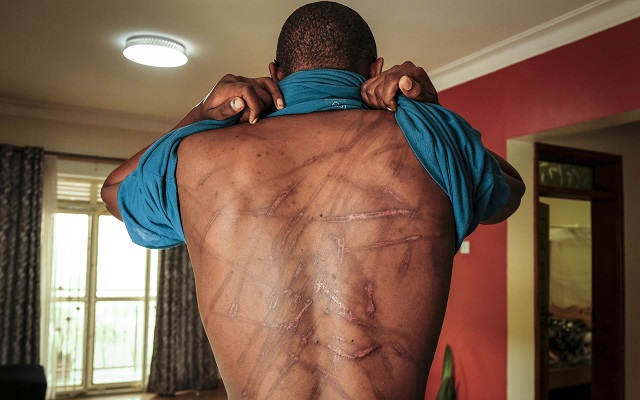
COMMENT | Olivia Nalubwama | It is now a year since a firestorm erupted in the wake of writer Kakwenza Rukirabashaija’s torture ordeal in state custody.
In December 2021, state agents broke into Kakwenza’s home, abducting him. In early January 2022, court ordered police to release Kakwenza – the police did not comply. On January 25, 2022, Kakwenza, who faced charges of offensive communication owing to his colorful language about President Yoweri Museveni and his son, General Muhoozi Kainerugaba, received bail.
Once out, Kakwenza did not miss a beat – images of his mutilated back trended at home and abroad. He did not hold back on the gore of his torture ordeal – he spoke of his tormentors using pliers to tear flesh from his thighs, among other nightmarish realities.
How surreal that as other Ugandans go about their daily lives eking out a living, there are those who make a living with their trusty bloodied pliers ready to tear and bleed Ugandans. The same Ugandans for whom the regime fought to liberate from the murderous pliers of past regimes.
Thanks to social media, public advocacy against state-sanctioned acts of torture galvanized around the images of Kakwenza’s scars. Confronted with Kakwenza’s mutilated body, regime apologists and opposition supporters recoiled collectively.
Kakwenza would later flee clandestinely into exile, where he remains to this day. In exile, Kakwenza has sharpened his
pen vociferously, ‘torturing’ the ruling regime with unrelenting choice insults. On his choice of expression, in May 2022, Kakwenza referring to his torturers, told the BBC, “They turned me into a monster and they must deal with the monster they created.”
Museveni, whose regime came to power riding on fighting the impunity of past regimes, has been as insipid on torture as he is on corruption. A year later, what does progress against torture look like? That we have to pose that question is damning of Museveni’s regime and, therefore, his legacy.
Despite his penchant for blaming the colonial-era African leaders, past regimes, ideologically bankrupt foreigners with their coterie of homosexuals, quisling citizens, the opposition and hapless pigs, Museveni has had the longest time to reset and do better. The buck, which has to stop somewhere someday, must be tayaad of limbo.
According to the 2021 Uganda Human Rights Commission (UHRC) annual report, torture continues to top human rights violations at 37 per cent. The report further reveals state actors remain undisputed champions of human rights violations.
At least 54 per cent of the complaints were against the Uganda Police Force (UPF), and 21 per cent against the Uganda Peoples Defence Forces (UPDF). The Central and Karamoja regions recorded the highest complaints against the army/UPDF, which the report attributed to the disarmament exercise in Karamoja and the enforced disappearances in the central region.
The leading complaint against the police was the violation of the right to personal liberty, followed closely by the violation of the right to freedom, and torture. The leading complaint against the army – torture.
That torture is amongst us, served up by mainly state actors is not news. State actors routinely act with brazen brutality on and off camera.
On January 31, Sanya Muhydin, a member of the opposition National Unity Platform, verbally protested his prolonged detention and military court trial. For his protest, a soldier grabbed Muhydin’s neck, choking him into silence before manhandling him out of the court.
If the soldier could do that publicly in a court, it is not hard to imagine the brutality that would assail Muhydin off camera. The brutality is so normalized that court continued routinely as if choking a man in court is the most nominal Ugandan thing ever.
A cursory glance at the latest court cases regarding torture shows the prosecution of private individuals is far more robust. On January 17, just days after going viral, 18-year-old Kaftah Queen appeared in court on charges of aggravated torture.
The accused, in the viral video, is seen alongside others assaulting a 15-year-old girl, Pretty Nicole. Queen, puffed up in volcanic anger, rains violence on Nicole, accusing her of making a pass at her boyfriend.
On January 31, the magistrate in sentencing Queen reiterated, “This is a deterrence sentence to you and other young girls out there. I want you to be an example that violence has no place in our country. I am sentencing you to three years’ imprisonment.”
Just like that, with breathtaking efficiency, the court case was done and dusted. In our country, which has no place
for violence, it should baffle us that a year later, there is not even a smattering of progress toward investigating and prosecuting Kakwenza’s tormentors.
Last January, UHRC officers visited Kakwenza in prison and confirmed Kakwenza had visible scars and injuries indicating evidence of torture. UHRC, which is mandated to investigate human rights violations, added vaguely, “We look forward to a judicial resolution of his matter.”
In looking forward to the “judicial resolution of his matter,” UHRC chose to sit on the fence when it could mow down the fence. Unsurprisingly, a year later, we are yet to hear an update from UHRC. For all we know, Kakwenza’s fertile imagination and flair for grandiloquent verses could have produced the scars on his body.
*******
 Olivia Nalubwama is a “tayaad Muzukulu, tired of mediocrity and impunity” smugmountain@gmail.com
Olivia Nalubwama is a “tayaad Muzukulu, tired of mediocrity and impunity” smugmountain@gmail.com
THIS ARTICLE FIRST PUBLISHED IN THE OBSERVER
 The Independent Uganda: You get the Truth we Pay the Price
The Independent Uganda: You get the Truth we Pay the Price


